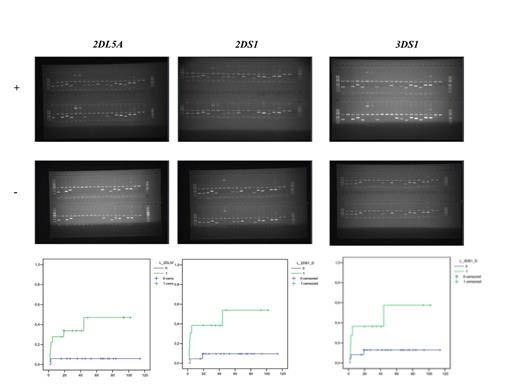Abstract
Introduction
Graft versus leukemia (GvL) effect after hemotopoietic stem cell transplantation (HSCT) is mediated by donor immune cells recovery. Natural Killer (NK) cell alloreactivity is controlled by the interaction of activatory receptors and inhibitory killer-immunoglobulin-like receptors (KIRs) with major histocompatibility locus class I antigens on the leukemia cells. Haploidentical setting is a plattform for NK cell alloreactivity however HLA identical setting remains unclear.
Methods and Patients
We performed KIR-genotyping of HLA-identical sibling donors in 35 pediatric CD34 selection peripheral blood stem cell transplantations to identify genetic factors affecting leukemia relapse and overall survival. Univariate analysis of leukemia relapse and KIR genotyping was performed in order to identify independent variables predictive of outocome for pediatric acute lymphoblastic leukemia (ALL), (n=20) and acute myeloblastic leukemia (AML), (n=15).
Results
Donor B haplotype was observed in 21 cases (60%). Statistical analysis shown that donor B haplotype was associated with significantly more relapse in leukemia pediatric patients (38% vs. 0%) and worse overall survival (40% vs. 7%). Further analysis revealed that 2DL5a, 2DS3 and 2DS5 were associated with an increased rate of leukemia relapse (47% vs. 6%, 54% vs. 10% and 58% vs. 13%, respectively) and 2DL5a, 2DS1 and 3DS1 were associated with a worse overall survival (48% vs. 6%, 64% vs. 10% and 58% vs. 13%, respectively). No difference was observed in patients KIR haplotype or donor-recipient KIR haplotype mismatch.
Conclusion
In our study, which included only reduced intensity conditioning without antithymocyte globulin followed by related peripheral blood stem cell transplantation, we found a significant worse impact of donor KIR B haplotype in stem cell transplantation outcome. Our results suggest that donor KIR B haplotype (2DL5a, 2DS3 and 2DS5) increases leukemia relapse and also donor KIR B haplotype (2DL5a, 2DS1 and 3DS1) confer significant survival damage to HLA-identical sibling HSCT.
Donor KIR genotyping (2DL5A, 2DS1 and 3DS1) impacts in overall survival.
Donor KIR genotyping (2DL5A, 2DS1 and 3DS1) impacts in overall survival.
No relevant conflicts of interest to declare.
Author notes
Asterisk with author names denotes non-ASH members.


This feature is available to Subscribers Only
Sign In or Create an Account Close Modal